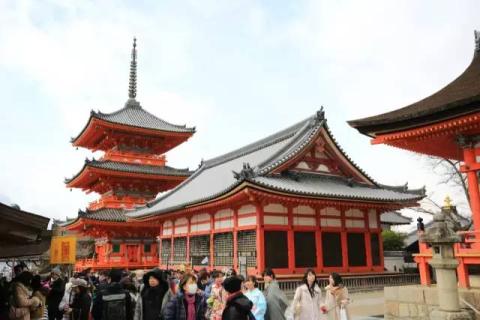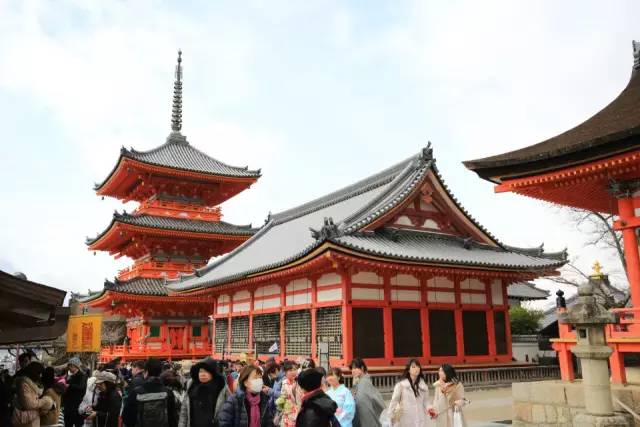
was founded in the Heian Era Kiyomizu-dera Temple is the oldest temple in Kyoto. is listed as a Japanese national treasure building and is a must-see in Kyoto. One of the tourist attractions. The mountain name of Kiyomizu-dera Temple is Mount Otowa, which is mainly dedicated to the Thousand-Armed Avalokitesvara and is the main temple of the Northern Hokōshu sect of Japanese Buddhism. Kiyomizudera was built in 778, earlier than Kyoto was established as the capital. It is a temple with a long history , The total area of the completely wooden temple reaches 13 Ten thousand square meters, by Master Cien Created, According to legend, Master Ci'en was Tang Monk Xuanzang's first disciple in Japan. A disciple.
Since its founding, Kiyomizu Temple has been burned down several times. Almost all of the current buildings were built by the third generation shogun Tokugawa Iemitsu in the early Edo period was rebuilt in 1633. The main hall of Kiyomizu-dera Temple houses the eleven-faced Thousand-Armed Avalokitesvara statue. This statue is located every 33 was only open to visitors, and the most recent opening was in AD 2000. The main buildings of Kiyomizu Temple are: Three-story pagoda, sutra hall, Kaishan hall, Hongmen, Chaocang hall, main hall, and Amitabha hall. The surrounding buildings include the Nio Gate, the horse station, the bell tower, and the Hokusomon Gate.
Kiyomizu-dera Temple is named after the clear water in the temple ,Go down the stone steps of Okuin It is Otowa Falls,tanThe water is divided into three notes along the eaves of the pavilion, which represent longevity, health and wisdom respectively. Visitors can take a ladle with a water cup to catch the spring water, and then drink it all in one gulp. It is said that drinking one cup is very effective. But please note that you can only choose one shot of spring water. If you are too greedy and drink all three shots, your wish may not come true. 
Kiyomizu-dera Temple is a pillar structure temple. The width of the main hall is 19 meters, and the depth is 16 meters , The temple building is magnificent and ingeniously structured without using a single nail. The six-story wooden platform made of torch wood in the temple is rare in Japan. There are nearly 30 wooden structure buildings in the temple, including the main hall, bell tower, triple pagoda, sutra hall, local shrine, and achievement garden. wait. The main hall is listed as a Japanese national treasure. It rises against the mountain, with a width of 19 meters and a depth of 16 meters, the roof of the hall is paved with several layers of bead-shaped cypress bark tiles.
The main hall in the center of the temple is Kanei10 year(1633year) A large wooden building built, adopts the "suspended" technique without using a nail, is supported by 139 a large log tens of meters high. Standing majestically on the steep cliff, The floor is paved More than 410 cypress boards, form suspended "stage",It is called Qingshui Stage. Because the stage was very high, slipped and fell, no chance of escaping his life. So much so that an idiom was born in Japanese : " Jump off the stage in Qingshui " is used to describe doing something resolutely. From " Stage"Looking around, you can have a panoramic view of most of Kyoto.
If the weather is clear, you can even see Osaka in the distance. The Qingshui Stage is surrounded by green trees. The cherry blossoms are blooming in the spring and the maple leaves are rustling in the autumn. The scenery of the Qingshui Stage is wonderful.
Behind Kiyomizu Temple, there is a small shrine called Jishu Shrine. The shrine and the temple are two unrelated things. The gathering of religious places of worship may be a sight that can only be seen in Japan. It is said that in The Dizhu Shrine is particularly famous for seeking marriage. Many good men and women come here to seek marriage. 
The parking lot is still a long way from Kiyomizudera Temple. I estimate it is 2 miles. There are several turns and we have to cross Kyoto in the middle. Banden Railway, there is a station "Gojo" at the intersection. When we were about to pass, a train came and stopped everyone. The railings just opened, but few people passed. Another train came from the other direction, and Mirai had no time to pass. Other group members stopped us again, and everyone had to wait here. Yang Zi, as well as the domestic tour guide who came with him, were greeting everyone before and after to avoid going astray. What's more coincidental is that when we came back, we were stopped by the train again. It seemed that we were either too lucky or too unlucky. Such a small probability has happened.
The shops on both sides of the street are one after another, all selling special products, including paper umbrellas, fans, Buddha statues, bowls, matcha ice cream, cakes and other various small commodities. There are many people, and they are crowded together. Traffic in Japan is on the left. There are many Chinese, European and American tourists and pilgrims who come here. They are used to driving on the right. Some people follow local customs of driving on the left. If they are new here, they will face the small commodities on the street. I also want to feast my eyes on it, so there will be tourists heading to Kiyomizu Temple on both sides, and people going back to the parking lot will have to walk in the middle of the street.
Before coming to Japan, I had agreed and even encouraged the children to taste more special snacks and appreciate more exotic scenery and people. At this time, they were already looking forward to matcha ice cream. When they saw it, My daughter, who could speak a word or two in Japanese, did not hesitate to buy it. She even asked me and her mother if we wanted it. I was interested in looking around and did not let them buy it for me.
You need to buy a ticket to visit the main hall of Kiyomizu-dera Temple. When Yang Zi went to buy the ticket, I saw a board with the wishes written by believers neatly hung on it. Small wooden boards, several boards hanging in one place. This small wooden board is called "Ema" and is obtained from the social affairs office. It is usually pentagonal and painted on the back to imply divine power. The board on which Ema is hung is naturally called "Ema hanging". It’s just that after I visited, I wanted to take some more photos of the pagoda. When I came here again, I found that temple staff were cleaning it up, and there were not many ema hanging left. 
When entering the gate of Kiyomizudera Temple, there is a staff checking tickets. There is no amount on the ticket, and there is no number. It is simple. The staff just takes a look to see if there is a ticket. No. Make any marks. The sign next to the door reminds us that the closing time is 6 o'clock, which is enough time for us.
Walking along the flow of people, there is no feeling of crowding. Wooden temple It exudes the fragrance of wood. The buildings in the temple are well maintained and exude a heavy texture. At the same time, it is full of tranquility and tranquility. The red paint adds a lot of brightness to the simple tradition. The beautiful hall exudes its unique flavor no matter what angle it is.
There were not many people on the stage. Because it was under maintenance, I did not go to the edge of the stage. I stayed for a while and then moved forward. There are two roads ahead. The steps on the left go straight down. Going straight is a cement road, which is very gentle. I chose to go straight.
Going forward along the road, bypassing the small valley, you can see the Qingshui Stage more clearly from the opposite side. There are many dry branches with fallen leaves on all sides. It must be that the mountains will be red in autumn.
The ditch on the inside of the road is being repaired, and the residue in the ditch is also being cleaned. The ditch cover is made very carefully, and the ditch walls are neat and tidy. The workers are working at a slow but slow pace. Being serious and doing things seems to be what we need to learn more. 
I quickly walked to the pavilion under the stage. There were many people queuing up to drink water. I was just looking for I took a photo from a very small angle and looked at it quietly for a while without going to drink. This pavilion is called "Hand Water House", which is where believers wash their hands and rinse their mouths before worshiping. There is also a set of sacred and peaceful rituals in front of the hand water house: first pick up the wooden ladle with your right hand, draw water from the water dish and wash your left hand; pass the ladle to your left hand, then wash your right hand; then pass the ladle back to your right hand, and pour a little Put the water in the palm of your left hand, rinse your mouth with the water in your hand; wash your left hand again; hold the ladle with both hands, stand the ladle up, let the remaining water in the ladle flow down the ladle handle, clean the ladle handle and put the ladle back. After completing this ritual, the hands, mouth and wooden ladle become washed clean . 
We walked to the gate of Kiyomizu Temple without any obstruction. If we go in reverse direction, we can walk to all the places we just visited. It seems that no one does this, but if we go to China, The mainstream route for visiting must have been changed by fare evaders.
When I came to Banjie again, I asked my daughter to be my adviser and chose a fan as a gift for a friend. Several of the gifts she gave me were taken away by my daughter without any courtesy and without shame. He said, " I just like it so much. What’s dad’s is mine" Alas, a little cotton-padded jacket is almost the same as a little robber!

After coming out of Kiyomizudera Temple, we headed to Geisha Street, the last stop of the day.
